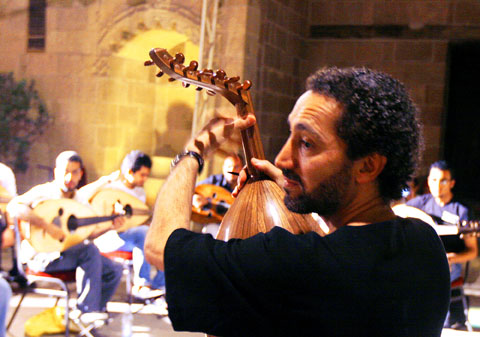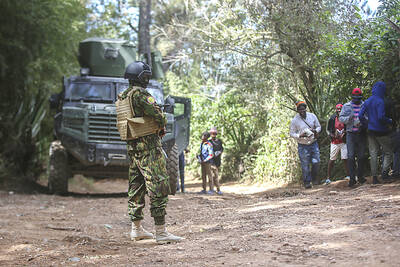Iraqi composer Naseer Shamma is such a master of the traditional Arab stringed instrument called the oud that he has taught himself to play one-handed.
He was motivated not by showmanship but by friendship. He developed the technique to help a former student who returned from the Iran-Iraq war without his right arm.
Shamma, one of Iraq’s most famous oud players, is often moved by his country’s tragic recent history, from the war with Iran in the 1980s to the brutal dictatorship of Saddam Hussein and the plight of Iraqi refugees driven from home in the violence after his ouster. He donates concert proceeds to pay for medical care and schooling for refugees and lobbies Arab governments to offer aid.

PHOTO: AP
The soft-spoken, 45-year-old composer says he was compelled to act after he met poor refugees last year on a visit to Syria.
Destitute Iraqis now flock to his Cairo office for help, and Shamma is distraught he cannot do more.
That’s why his music grows darker, he says, as Iraq’s strife and the hardships of its scattered people come crashing into his unusual compositions for the ancient Arab lute, much loved by Iraqis for the nostalgia it stirs.
“You know it’s more deep, my music, and more strong now, because always there is pain everywhere ... and in my heart. And of course all that is very clear in my music,” he says on a recent night at the oud school he runs.
Beit al-Oud, or the House of the Oud, sits in Cairo’s Islamic quarter in one of the medieval inns that served traveling merchants.
The building’s narrow, beautifully carved stone passageways lead to an inner courtyard where Shamma gives classes for dozens of students. It’s one of five centers he has set up around the Arab world, helping the Iraqi oud to flourish outside the land where it was born.
Drawn to the oud as a child, Shamma became part of a school of Iraqi musicians that transformed it into a solo instrument, freeing it from its traditional role in the classical Arab orchestra or accompanying singers. He went on to develop a style that blends East and West, modern and traditional.
His most stunning innovation came about because of the 1980 to 1988 Iran-Iraq war, which left thousands of people missing limbs.
One was a friend and student. A sobbing Ahmed Fayaq, his right arm lost in battle, greeted Shamma after a 1986 concert. In the emotion of the moment, Shamma sought to give him hope with what seemed an impossible promise: The next time Fayaq saw him performing, he would be playing with his left hand only.
“I stayed in my house four months without giving any concerts,” Shamma said. Every day I practiced, practiced, practiced. At the end of a month, I thought, ‘This is impossible.’ But in the end I did it ... I kept my promise.”
Since then, Shamma has taught the technique to disabled musicians. The fingers of his left hand vigorously tap at the strings along the instrument’s neck, producing an exciting percussive effect that reverberates through the oud’s belly, transforming it into both drum and stringed instrument.
Close your eyes and you can’t imagine the sound is generated by just one hand.
Another innovation was Shamma’s redesign of the oud, based on a ninth-century drawing. Most ouds have five identical pairings of strings known as courses, plus a single string. Shamma’s revised oud has eight courses.
Matthias Wagner, who crafts European lutes and ouds in Badenweiler, Germany, says Shamma’s unusual openness to such experimentation helps ensure the survival of an instrument with roots going back to 2350BC in Mesopotamia.
He believes that instruments and music that don’t change with the times may end up forgotten.
It is the troubled history of Shamma’s homeland that has most influenced his playing. Two million Iraqi refugees are stranded on the outskirts of Arab capitals surviving on menial jobs and dwindling savings, and Egypt is home to as many as 120,000, according to government estimates.
Shamma and five friends spent US$51,000 this year to send more than 200 students to school. He raised another US$24,000 for a UN refugee agency with a concert in Damascus, Syria, in June.

A fire caused by a burst gas pipe yesterday spread to several homes and sent a fireball soaring into the sky outside Malaysia’s largest city, injuring more than 100 people. The towering inferno near a gas station in Putra Heights outside Kuala Lumpur was visible for kilometers and lasted for several hours. It happened during a public holiday as Muslims, who are the majority in Malaysia, celebrate the second day of Eid al-Fitr. National oil company Petronas said the fire started at one of its gas pipelines at 8:10am and the affected pipeline was later isolated. Disaster management officials said shutting the

DITCH TACTICS: Kenyan officers were on their way to rescue Haitian police stuck in a ditch suspected to have been deliberately dug by Haitian gang members A Kenyan policeman deployed in Haiti has gone missing after violent gangs attacked a group of officers on a rescue mission, a UN-backed multinational security mission said in a statement yesterday. The Kenyan officers on Tuesday were on their way to rescue Haitian police stuck in a ditch “suspected to have been deliberately dug by gangs,” the statement said, adding that “specialized teams have been deployed” to search for the missing officer. Local media outlets in Haiti reported that the officer had been killed and videos of a lifeless man clothed in Kenyan uniform were shared on social media. Gang violence has left

US Vice President J.D. Vance on Friday accused Denmark of not having done enough to protect Greenland, when he visited the strategically placed and resource-rich Danish territory coveted by US President Donald Trump. Vance made his comment during a trip to the Pituffik Space Base in northwestern Greenland, a visit viewed by Copenhagen and Nuuk as a provocation. “Our message to Denmark is very simple: You have not done a good job by the people of Greenland,” Vance told a news conference. “You have under-invested in the people of Greenland, and you have under-invested in the security architecture of this

Japan unveiled a plan on Thursday to evacuate around 120,000 residents and tourists from its southern islets near Taiwan within six days in the event of an “emergency”. The plan was put together as “the security situation surrounding our nation grows severe” and with an “emergency” in mind, the government’s crisis management office said. Exactly what that emergency might be was left unspecified in the plan but it envisages the evacuation of around 120,000 people in five Japanese islets close to Taiwan. China claims Taiwan as part of its territory and has stepped up military pressure in recent years, including